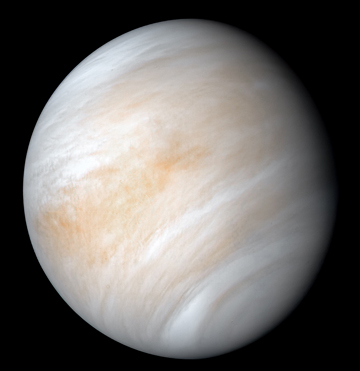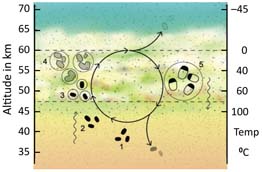|

The surface of Venus makes hell seem inviting — the atmospheric pressure is 92 times that of Earth and its temperature is 735 K (462º C, 863º F), far too hot to support biological life — even our robotic probes ceased functioning in a couple hours.
Yet, as early as 1967, Morowitz and Sagan speculated about the possibility of life in the clouds high above Venus’ torrid surface. Life does exist in Earth’s clouds; could it also exist in our sister planet’s clouds that reach altitudes of up to 70 km (42 miles)?
A new observation and a new hypothesis have re-energized that speculation.
The new observation is the unexpected detection of phosphine gas (PH3) in Venusian clouds at a concentration of 20 ppb (parts per billion). In this environment, phosphorous should rapidly oxidize, forming P2O and similar molecules, so this observation implies a continuing phosphine source.
While phosphine is highly toxic, it is produced on Earth by some bacteria and by our own industries. It is also produced naturally on hydrogen-rich gas giants, like Jupiter and Saturn. It was not expected in the atmosphere of Venus.
The group that made this new observation claims that, “after exhaustive study”, chemists cannot identify any abiotic process capable of providing a continuing phosphine source on Venus.
The new hypothesis comes from scientists at MIT, UC Berkeley, and the UK Universities of Cardiff and Cambridge (“Seager+6”). They say life might exist within liquid droplets in the Venusian clouds in brief, but repeating, cycles. Presumably, this life produces the observed phosphine.
Life in the clouds of Venus is no cakewalk. Its atmosphere is mostly sulfuric acid; it is 100 billion times more acidic, and has 50 times less water vapor, than anywhere on Earth.
Seager+6 say that, during their active phase, Venusian “microbes” might thrive in clouds, as illustrated in this sketch from their paper. At 53 km (32 miles) above the surface, the temperature is about 50º C (122 ºF).

The microbes might have a radius of 1 µm (1/25,000 inch), and are thus effective cloud condensation nucleation sites (stage 3 in the image). Photosynthesis could provide the microbes enough energy to extract water from sulfuric acid. Within tiny water droplets, the microbes would be protected from the desiccating atmosphere, and could grow and reproduce (stage 4).
As in our atmosphere, the upward pressure on a tiny ball is proportional to its area, and hence its radius squared, where as the downward pull of gravity is proportional to its volume, and hence its radius cubed. This means small droplets can float, while larger ones fall.
Over the course of several months, the Venusian microbes’ water droplets would grow large enough for gravity to overcome pressure, and force them downward (stage 5). As they drop, temperature and pressure rise rapidly and the water evaporates.
The desiccated microbes become spores (stage 1), with radii of perhaps 0.2 µm. At that size, spores are comparable to other particulates at that altitude and can remain aloft for centuries, Seager+6 say.
Eventually, upward drafts might lift the spores up to their habitable zone (stage 2), where their life cycle repeats.
As to its origin, Seager+6 say life could have evolved on Venus, perhaps when water existed on its surface over 700 million years ago, and migrated into the clouds as surface temperatures rose. Or, perhaps meteorites ejected by asteroid impacts on Earth brought life to Venus. Or, as suggested by Siraj and Loeb of Harvard, asteroids grazing Earth’s upper atmosphere could have picked up microbes and then transported them to Venus — they estimate the number of potentially transporting asteroids to be 600,000.
All this is intriguing but highly speculative. In the few weeks since the first phosphine report, more than a dozen groups have published responses. One group suggested the continuing phosphine source might be Venusian volcanoes, rather than life. Other groups have proposed NASA missions to probe Venusian clouds for signs of microbial life.
The discovery of any form of alien life would be extremely exciting.
My first question would be: Do they have DNA like ours?

Best Regards,
Robert
October 2020
Note: Previous newsletters can be found on my website.
|